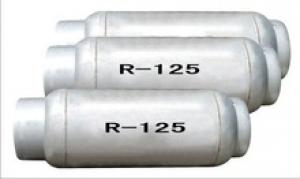Refrigerant R32 in Disposable Cyl
- Loading Port:
- Shanghai
- Payment Terms:
- TT OR LC
- Min Order Qty:
- -
- Supply Capability:
- 1000MT m.t./month
OKorder Service Pledge
OKorder Financial Service
You Might Also Like
Specifications
1.Easy to evaporate
2.OEM is welcomed
3.Delivery within15 days
4.High purity
Difluoromethane(HFC-32)
Chemical Formual | CH2F2 |
Molecular weight | 52 |
Boiling point,(760 mmHg) | -51.65 |
Vapor pressure | 1.38 |
Critical temperature, | 78.1 |
Critical pressure,Mpa | 5.782 |
Solubility in water(wt%,25) | 1.85 |
Liquid denisty(25,latm,water=1) | 0.0958 |
Gas denisity(21.1,latm,air=1) | 1.8 |
Appearance | Colorless, no turbid |
Odor | Odorless |
Purity≥ % | 99. 8 |
Moisture ≤ % | 0. 001 |
Acidity ≤ %, HC1 | 0 .00001 |
Residue ≤ % | 0.01 |
Properties and applications:
R32 is a colorless liquid field gas. As a main component of blend refrigerant, it can be used to blend substitute R407c and R410a for R22.
Packing:
670kg/926L, 30KG/40L, ISO TANK.
- Q: What is the relationship between hydrocarbon and hydrocarbon derivatives?
- The hydrocarbon is the parent of the organic compound, and the other various organic compounds can be regarded as derivatives of one or more hydrogen atoms in the hydrocarbon molecule being replaced by atoms or radicals of other elements.
- Q: Are there two derivatives of equivalent hydrogen?
- You give the scope is too broad, at least to set in what kind of functional group range ah.
- Q: What is "organic" and "inorganic" in chemistry?
- Carbon-free substances or carbon oxides, carbonates, bicarbonates are organic matter
- Q: What is the difference between organic matter and inorganic matter?
- Inorganic matter is an inorganic compound. Generally refers to the elements other than carbon elements, such as water, salt, sulfuric acid, lime and so on. However, some simple carbon compounds such as carbon monoxide, carbon dioxide, carbonates, carbonates and carbides, because of their composition and properties and inorganic similar, so also as an inorganic to study. The vast majority of inorganic matter can be classified as oxides, acids, alkalis and salts.
- Q: Is the system name of a hydrocarbon derivative named if the question can be named according to the nomenclature of the alkane?
- Halogen can be named after the alkane, the other can not
- Q: What is organic?
- Organic products are from the organic agricultural production system, according to the international organic agricultural production requirements and the corresponding standard production and processing, and through third-party geographical and organic certification bodies certified all agricultural and sideline products, including food, vegetables, fruits, dairy products, animal products , Honey, aquatic products, spices, cosmetics, and even textiles, forest products, biological pesticides, organic fertilizers and so on. Is the organic cultivation of pesticides, fertilizers, contaminated raw soils, grows in the closest way to nature, and never uses synthetic compounds, fertilizers and transgenic technologies during the growth process. In the process of production In the absence of any synthetic chemical composition. From the processing, production, packaging the whole process is in line with environmental protection and health principles. International standards of organic certification required by the third-year certification bodies from the cultivation, processing, production, manufacturing, to the finished product wholesale process for review.
- Q: Rush! Hydrocarbon and hydrocarbon derivatives system information includes chemical formula, common name, Chinese name and so on
- The system is too difficult to summarize. Too much.
- Q: Why can organic matter be unique in chemical substances? What is the nature of the C atom?
- Carbon, and can be spun, sp2, sp3 hybrid, so CH, CC, CO, CN, C = C, C = O, C = N and other covalent bonds can be formed and the key size is moderate, So these keys can also be more easily broken and generate new compounds. For silicon, the type of hybrid is mainly sp3 (no O = Si = O this molecule exists), but the Si-O bond bond energy is greater than Si-C, Si-Si, Si-H, so these keys are It is easy to break to produce SiO2, so there is the most natural Si-O compounds, and this compound is very stable, difficult to break down or other reactions.
- Q: Carbon compounds (except inorganic carbon compounds), hydrocarbons and derivatives of the general term is?
- Hydrocarbons and hydrocarbon derivatives
- Q: How the most primitive life on earth is produced under what conditions
- Girl empty bird, YY out drop
Send your message to us
Refrigerant R32 in Disposable Cyl
- Loading Port:
- Shanghai
- Payment Terms:
- TT OR LC
- Min Order Qty:
- -
- Supply Capability:
- 1000MT m.t./month
OKorder Service Pledge
OKorder Financial Service
Similar products
Hot products
Hot Searches
Related keywords























